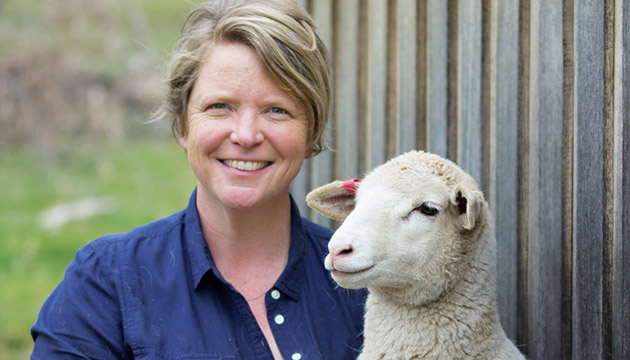Anna Kelly grows the lamb that she sells through farmers markets and delivers to restaurants and chefs.
Story By Kathy Mexted
A mob of dorper sheep, their fleeces in varying stages of shed, mill about a holding yard. As she skirts the fence, Anna Kelly brushes her hand across the top of a ewe’s head and speaks to it.
When the mob groups at the end of the run, Anna swiftly scoops up a six-month-old lamb. She is in tune with its mood and gives her confused charge a soothing rub under the chin and whispers calmly. She expertly hoists it into the trailer then, firmly folding it into her arms, comments on the nervous animal’s rapid breathing and heart rate. They remain in contact for the next 30 minutes, the lamb eventually becoming relaxed and compliant.
Anna grew up in the heart of Merino country at Conargo, NSW. After finishing school in Geelong, running a Melbourne-based horticultural business, and returning to the 2500-hectare family farm in her early thirties, Anna had established good relations with chefs and restaurateurs whose passion for food matched her own.
“I thought I was coming home to grow wool – and I would have loved that – but eight years ago we were in drought,” Anna says. “I helped Dad with cattle and cropping but it wasn’t financially viable so I had to find something for myself that was manageable for my environment and for me.” She began with 16 dorper ewes in lamb and now, eight years later, runs 10 rams with 800 ewes, whose progeny she markets directly to end users.
“We bought a property about 40 kilometres away, just south of Deniliquin, which, between farmers’ markets and deliveries, I manage with my family’s help,” Anna says. “I absolutely love food and immediately my foodie mates were keen to try my product. I chose dorpers because they are hardy and will graze on native grasses and vegetation, so when pasture is thin they will forage, which is good for their immunity. They are also fierce protectors of their young, which they prolifically generate, so there are minimal losses to predators. I generally get about three lambings every two years – often twins – and have introduced a bit of Merino into the flock to increase carcass size.”
This Story is from Issue #99
Outback Magazine: Feb/Mar 2015










